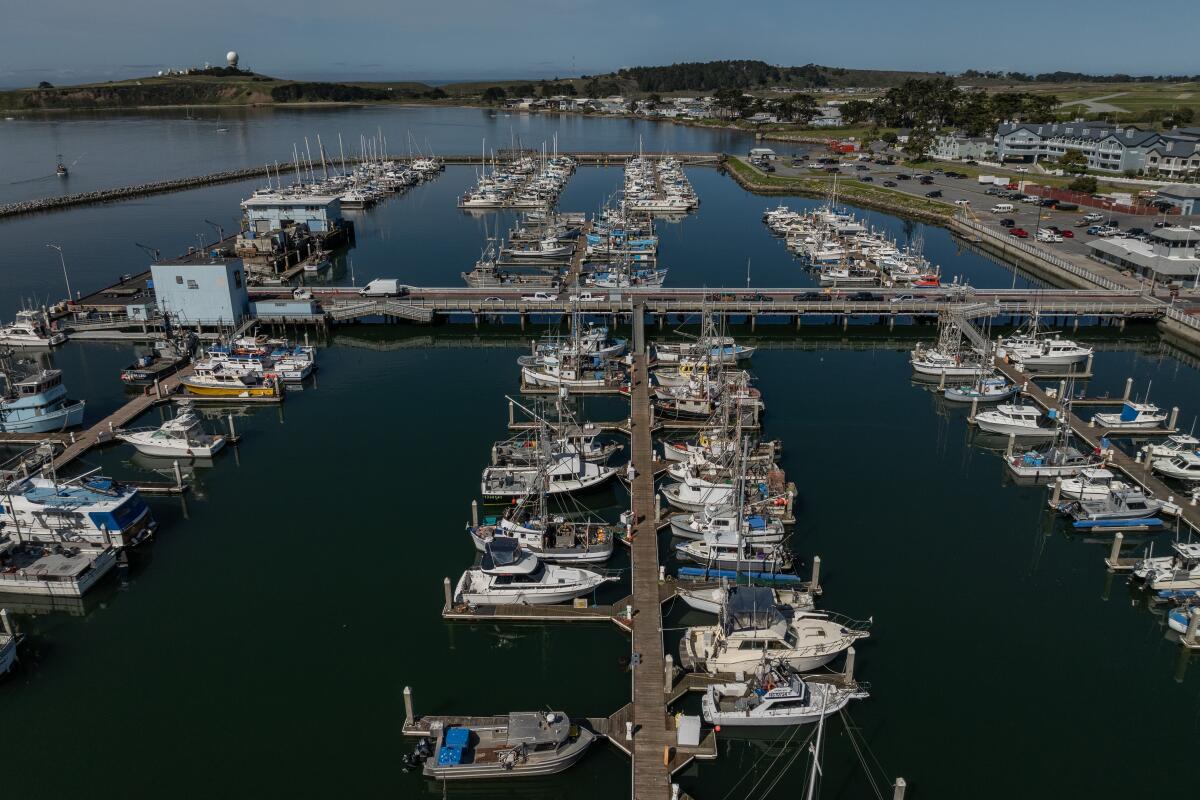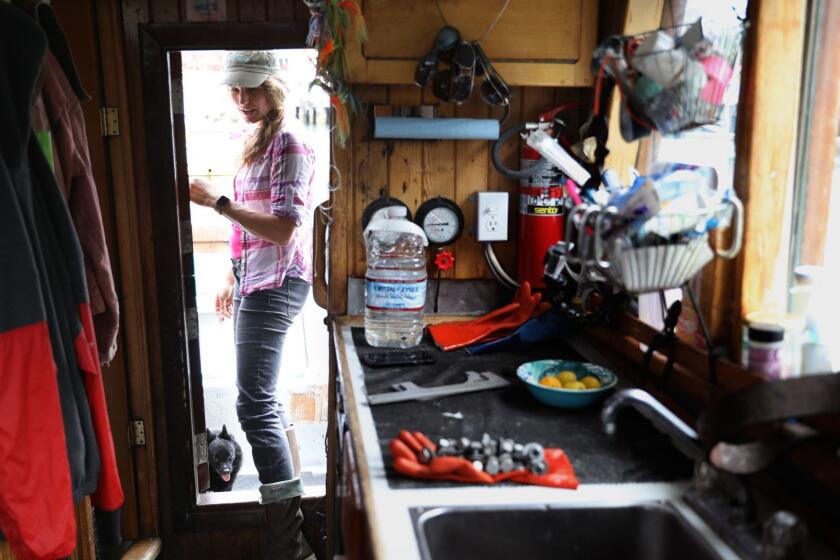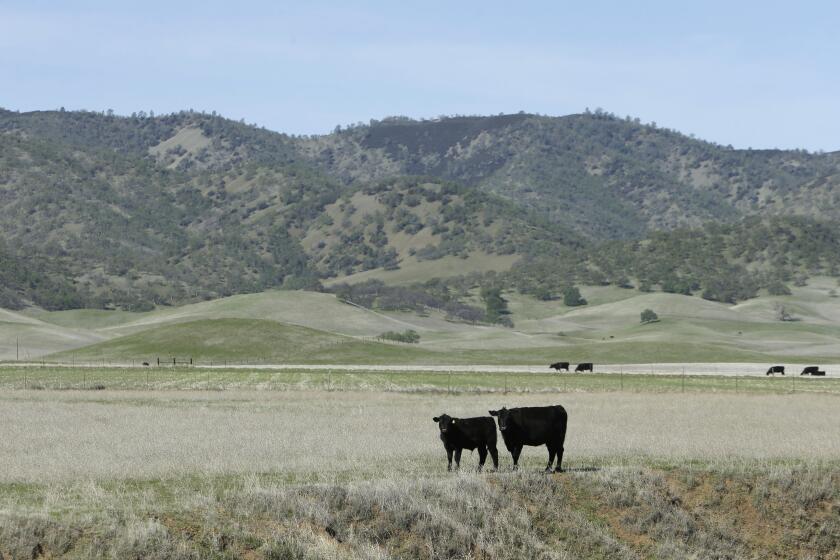Column: The salmon industry faces extinction — not because of drought, but politics and government policies

- Share via
Snapshots from an environmental and economic disaster:
Kenneth Brown, the owner of Bodega Tackle in Petaluma, reckons he has lost almost $450,000 in the last year.
“I haven’t taken a paycheck in seven or eight months,” he says. He has had to lay off all but one employee, leaving himself, his son and the one remaining worker to run the business.
James Stone, board president of the Nor-Cal Guides & Sportsmen’s Assn., says more than 120 guides who serve recreational fishing customers in and around the Sacramento River and San Francisco Bay have all but been put out of business, costing the economy as much as $3.5 million a year.
Salmon have survived droughts in California for millennia. But when on top of that you have incredible water diversions and temperature pollution, you’re killing these baby fish. And when you kill the baby fish, they don’t come back as adults.
— Scott Artis, Golden State Salmon Assn.
Sarah Bates, the owner of a commercial fishing boat in San Francisco, has seen 90% of her income washed away. She has watched a commercial fleet capacity of nearly 500 boats reduced nearly to zero.
The circumstance affecting all three is the shutdown of the crucial fall-run salmon fishing in California, which the Pacific Fishery Management Council, a governmental body, recently extended for 2024, the second year in a row.
Get the latest from Michael Hiltzik
Commentary on economics and more from a Pulitzer Prize winner.
You may occasionally receive promotional content from the Los Angeles Times.
The main reason is the decline of the salmon population in the Sacramento River to such an unsustainable level that there’s reason to fear that it may not recover for years, if ever — unless government policies are radically reconsidered.
Commercial fishers who relied on the fall-run salmon as their dominant source of income have struggled to find alternatives.
“Some people are bringing in black cod or rockfish or albacore,” Bates told me. Some land Dungeness crab. But prices for those products don’t match the value of chinook salmon.
“That allows for some income, but doesn’t really make up the difference for what you lose,” Bates says. “There are members of the fleet who have taken land jobs, or are relying on household members to pay the bills.”
One can’t minimize the scale of the shutdown, which follows a long-term decline in the fishery and is the first such shutdown since 2008-09, which was driven by a severe drought. In 2022, the last year of salmon fishing in California, the fleet consisted of 464 commercial vessels, down from 4,750 in 1980.
Private and chartered recreational trips in California, which reached 98,900 in 2022 — down from 148,000 in 2012 — have also been shut down.
The closing of both categories has rippled across the entire fishing economy, affecting hotels and restaurants that catered to recreational fishing customers as well as bait and tackle shops. For Brown’s Petaluma shop, there are no sales of bait or commercial gear — “no more boots, no more rain slickers, all that business is gone and there’s nothing to replace it.”
Heather Sears has been fishing for salmon out of this unassuming coastal community for nearly two decades.
There’s more to the salmon crisis than the devastation of livelihoods of tens of thousands of Californians working in an industry valued at more than $1.4 billion annually.
The crisis underscores the utter failure of the state’s political leaders to balance the needs of stakeholders in its water supply. In this case, the conflict is between large-scale farms on one side and environmental and fishery interests on the other.
For decades, agribusiness has had the upper hand in this conflict. It’s not hard to discern why: The growers have more money and therefore more political influence. Westlands Water District, the vast irrigation district that sprawls over Fresno and Kings counties in the Central Valley — the largest such district in the nation — spent more than $4.7 million on Sacramento lobbying over the last decade.
During the same period, Stewart Resnick, whose Roll International conglomerate owns the Central Valley almond orchards that are the largest growers of those nuts in the world and enormous consumers of water, donated $2.8 million to political campaigns in California, chiefly to Democratic candidates and in support of ballot box initiatives; among his contributions was $125,000 to oppose the 2021 recall of Gov. Gavin Newsom.
Officially valued at $1.4 billion a year, the salmon fishery can’t hope to compete with agriculture on a dollar-for-dollar basis. The market value of all agricultural products in California was $59 billion in 2022, according to state figures; salmon weren’t counted. The 10 most lucrative farm crops, led by dairy products, brought in some $35 billion that year.
The salmon fisheries are bellwethers for ecological health generally. “Fishermen are directly dependent on a healthy ecosystem,” says Barry Nelson, an advisor to the Golden State Salmon Assn. Their fortunes reflect not merely adequacy of water flows in California rivers and bays, but water quality. Any factor that falls outside a given range can produce a crash in fish populations, endangering whole species while putting men and women out of work.
As my colleague Ian James has reported, a key factor in the survival of the salmon population is water temperature. The diversion of ever more water from the federal government’s Shasta Dam for farm irrigation has driven temperatures in the Sacramento River to murderous levels.
The Sites Reservoir won’t provide much water to farmers and urban residents, but it will cost a fortune and wreak unimaginable environmental damage
That river, Nelson points out, is “the most important salmon-producing system south of the Columbia River.” But California authorities haven’t required the federal Bureau of Reclamation, which owns and manages the dam, to meet temperature standards downstream of the dam, even though it has the power to do so. “The state just hasn’t done its job,” Nelson says.
Talk to stakeholders in the salmon fishery, and one term keeps cropping up: “water management.” Their point is that drought isn’t the most important factor in the survival of the species — policy is, specifically the management of water supplies so that they’re balanced among users and that serving irrigation demand from farmers doesn’t wipe out competing interests, especially during dry years.
To better understand the threats to salmon, it helps to know about their life cycle. Salmon live and breed on a three-year timeline. Adult fish swim in the ocean but migrate upstream to lay eggs in the gravel beds of inland rivers. After they hatch, the baby fry and juveniles, called smolt, begin migrating downstream, typically via San Francisco Bay, and out to sea. Then the cycle begins again.
The critical period for the fall-run salmon in the Sacramento is while the eggs are incubating in their gravel beds. At water temperatures of 54 degrees, they start being cooked to death. Irrigation releases from Shasta suck down the reservoir’s cold water, leaving surface water heated by the sun; that’s what ends up in the Sacramento River at spawning season.
In recent years, water in the spawning beds has been measured at 70 degrees or higher. In 2021, state biologists reported, 99% of winter-run chinook salmon failed to reach the Sacramento-San Joaquin River Delta and the bay.
“Salmon have survived droughts in California for millennia,” says Scott Artis, executive director of the Golden State Salmon Assn. “But when on top of that you have incredible water diversions and temperature pollution, that’s what’s killing these baby fish. And when you kill the baby fish, they don’t come back as adults.”
The need for painstaking water management is the result of human interventions in California’s natural environment. Over the last 100 years, rivers across the Central Valley were dammed to provide irrigation for farms, blocking salmon from their natural habitats. The federal government opened salmon hatcheries to compensate, but they have not produced enough fish to make up for the losses from poor water management.
Meanwhile, the water demands of California growers became less flexible. Crops that could be fallowed during dry spells, leaving more water for the environment, were supplanted by almond and pistachio orchards, which require water in wet years and dry. California almond acreage rose to 1.38 million last year from 418,000 in 1995. In the same period, pistachio acreage rose to more than 461,000 from 60,300.
Trump’s water giveaway to his rich backers will parch the rest of the state.
The crisis that has unfolded in 2023 and this year has its roots in actions taken during the Trump administration. In 2019, Trump installed David Bernhardt, a lobbyist for agricultural water users, as Interior secretary.
As an attorney in private practice, Bernhardt had sued the government on behalf of the giant Westlands Water District to challenge its enforcement of the Endangered Species Act, which conflicted with Westlands’ interests. As Interior secretary, Bernhardt advocated for loosening enforcement of the act.
In 2020, Bernhardt and Trump implemented an increase in water deliveries to big farmers under conditions that spelled disaster for the salmon fishery, among other ecological issues. California objected, asserting that Interior’s official biological opinions, which concluded that the increases wouldn’t adversely affect salmon and other species, bore no “rational connection [with] the facts.” The Natural Resources Defense Council labeled the opinions “a plan for extinction” of salmon and other endangered species.
They went through anyway. The demands from agribusinesses in the Central Valley for more water had received a friendly hearing from the Trump administration and Republicans in Congress, who recognized that the valley was perhaps the only strongly Republican part of California. They decried the passage of water from inland reservoirs to rivers and out to sea as wasteful; as I wrote at the time, their single-minded service for the growers deprived the salmon fishery of its lifeblood.
The impact of the Trump policies was destined to be felt three years on. Indeed, last year only 6,160 adult salmon were estimated to have spawned in the Sacramento River, the worst level since the drought year of 2017 and obviously well below the annual average of 175,000 spawning from 1996 to 2005, the best period for the health of the salmon fishery over the last four decades.
Just two days after President Trump issued an utterly uninformed tweet about the causes of the California wildfires, his ulterior motives began to come into focus.
In January, Newsom responded to the salmon crisis with an action plan encompassing restoring salmon habitats, modernizing hatcheries, and removing impediments to salmons’ upstream migrations. The fishery community supports many of those initiatives, but also recognizes that the package is largely aspirational, for money hasn’t been appropriated to fulfill all its elements.
The Newsom administration also outlined plans in March 2022 to reach a series of voluntary agreements with agricultural water users over water sharing. Environmental and fishing groups, which weren’t part of the negotiations, weren’t impressed — a coalition of those groups, including the Sierra Club and the Golden State Salmon Assn., panned the proposal as “incomplete, unenforceable, inequitable, inadequate, and [lacking] a scientific foundation.”
Nor were the proposed voluntary agreements favored by two key federal agencies. The Environmental Protection Agency wrote in January that the absence of strong mandates for higher water flows in the Sacramento River meant that the plan would have only a “insignificant impact” on water temperature in the river. The National Marine Fisheries Service questioned whether the $740 million in state and federal funding needed to implement the voluntary agreements was realistic, since none of it had been appropriated.
In other words, Newsom’s approach involves a heaping helping of hand-waving. From the standpoint of the salmon industry, his other water policies, including a 45-mile water tunnel under the delta and fast-tracking construction of the Sites Reservoir in the western Sacramento Valley, will make things worse. The tunnel would turn the delta into “a deathtrap for salmon,” Nelson says, and the Sites Reservoir would degrade downstream waters, possibly increasing temperatures.
In many respects, the policies on the table are antiques. Some were developed without regard for the effects of global warming, and others reflect thinking that emerged in an era when California authorities thought the water supply was abundant, even unlimited.
That won’t do anymore. The federal government already lists Sacramento River winter-run chinook salmon as an endangered species and the spring run as a threatened species. The all-important fall run might not be far behind.
California’s water policies need to be subjected to a thorough rethinking, and money to fix all that’s broken needs to be appropriated, not just put on somebody’s wish list.
Fishermen and -women are a constitutionally optimistic class. “There’s always hope that things will get better,” Artis told me. But hope is waning. “We have to educate the Legislature and the public so we get those water flow and temperature protections, or we’ll be here again year after year with fishery closures.”
More to Read
Get the latest from Michael Hiltzik
Commentary on economics and more from a Pulitzer Prize winner.
You may occasionally receive promotional content from the Los Angeles Times.













